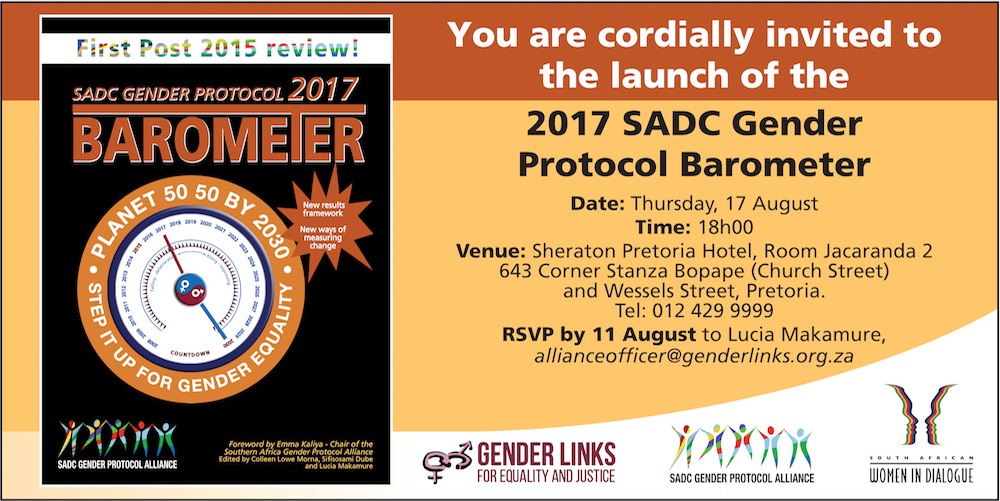By Byron Mutingwende
The 2017 Southern African Development Community (SADC) Gender Protocol Alliance makes a strong call for radical action to transform economies, institutions and society to make gender equality in the region a reality by 2030.
In a statement, the Alliance said it will this Thursday August 17 launch the 2017 edition of the annual SADC Gender Protocol Barometer (Barometer). The launch is set to coincide with SADC Day which will be celebrated in line with the 37th Heads of State and Government Summit theme, “Partnering with the private sector in developing industry and value chains.”
The Alliance is a coalition of gender networks in the fifteen SADC countries that campaigned for the adoption, ratification and revision of SADC Protocol on Gender and Development (Protocol).The Protocol is a unique sub-regional instrument that brings together the Sustainable Development Goals (SDGs), Africa Union (AU) Agenda 2063 and Beijing plus 20 and enhance these through specific targets.
Titled “5050 by 2030: Stepping up for gender equality “ the report brings together progress and implementation gaps in the eleven key areas of the revised Protocol and makes a strong call for radical action to transform economies, institutions and society to make gender equality in the region a reality by 2030. The report is coming out at a time when the Alliance national and thematic clusters are gathered in Johannesburg to strategise on a regional roadmap to achieve gender equality through the implementation of Agenda 2030.The meeting is taking place on the sidelines of the annual SADC Civil Society Forum.
“While the Barometer has tracked gender equality progress based on the Protocol since 2009, the latest report is the first gender audit in the region since the adoption of the revised Protocol and its accompanying monitoring, evaluation and reporting framework,” read a part of the statement.
The Barometer highlights progress using two yardsticks of measuring gender equality; the empirical SADC Gender and Development Index (SGDI) and the perception based Citizen Score Card (CSC). Both yardsticks have been revised in line with the Sustainable Development Goals (SDGs), Africa Union (AU) Agenda 2063 and Beijing plus 20.As expected the regional SGDI and CCS scores have gone down as the gender equality test becomes much harder. The SGDI at 61 % and the CSC at 65 % it shows that the region is less than two thirds where it needs to be to achieve gender equality by 2030.
At the time of publishing nine countries in the region including Botswana had signed the revised Protocol. The Protocol requires nine country to sign and ratify for it to become enforceable. The Barometer makes a strong call for more countries to sign including Mauritius which together with Botswana did not sign the 2008 Protocol.
“With 27% women in parliament, 23% in cabinet and 24% in local government the region is still a long way in achieving parity in women’s representation in public offices. Seychelles significantly dropped in the global rankings of women parliamentarians from 4th position in 2016 to 87th position after the September 2016 elections that saw a change in political party leadership and formation of a coalition government.”
The drop in women’s representation experienced in Seychelles as a result of change in political party leadership and the formation of the coalition government, emphasises that political commitment to electoral systems reforms and the adoption of quotas especially within political parties is essential to achieve women’s equal and effective participation in decision-making.
The report highlighted that women in SADC remain underrepresented in economic decision making and are paid less than men. They also have limited access to economic resources. However the new provisions of the Revised Protocol make a strong link to the global Post-2015 Agenda’s pledge to “leave no one behind.”
Gender based violence (GBV) remains unacceptably high in the region especially in South Africa where the country has recently been experiencing a surge of femicide cases. However the new Protocol takes a huge step forward in localising the Sustainable Development Goal 5 by moving from “halving” to “eliminating” GBV.
The Barometer shows that there is renewed emphasis on sexual and reproductive health and rights, recognising that that individual human rights and dignity, including the equal rights of women and girls and universal access to sexual and reproductive health and rights, are a necessary precondition for sustainable development.
Eleven SADC countries have reached the World Health target of 80% coverage of anti-retroviral treatment for pregnant women with six of them with over 95% coverage. SADC accounted for 134,500 averted infections in children; almost half of the global total of averted infections in 2016.
The Gender and Media Progress Study (GMPS) remains the latest research on women’s voices and their role in the media sector. It shows a paltry one percentage point increase in women sources in the media from 17% in the 2003 Gender and Media Baseline Study (GMBS) to 19% in the GMPS 2010, and 20% in the GMPS 2015.A new SADC Protocol provision on media ownership paves the way for a critical mass of women media owners and balanced participation of women in decision-making in media.
The Barometer is produced through support from the Commonwealth Foundation, Daikonia, Foundation and Amplify Change and the Southern Africa Trust.
